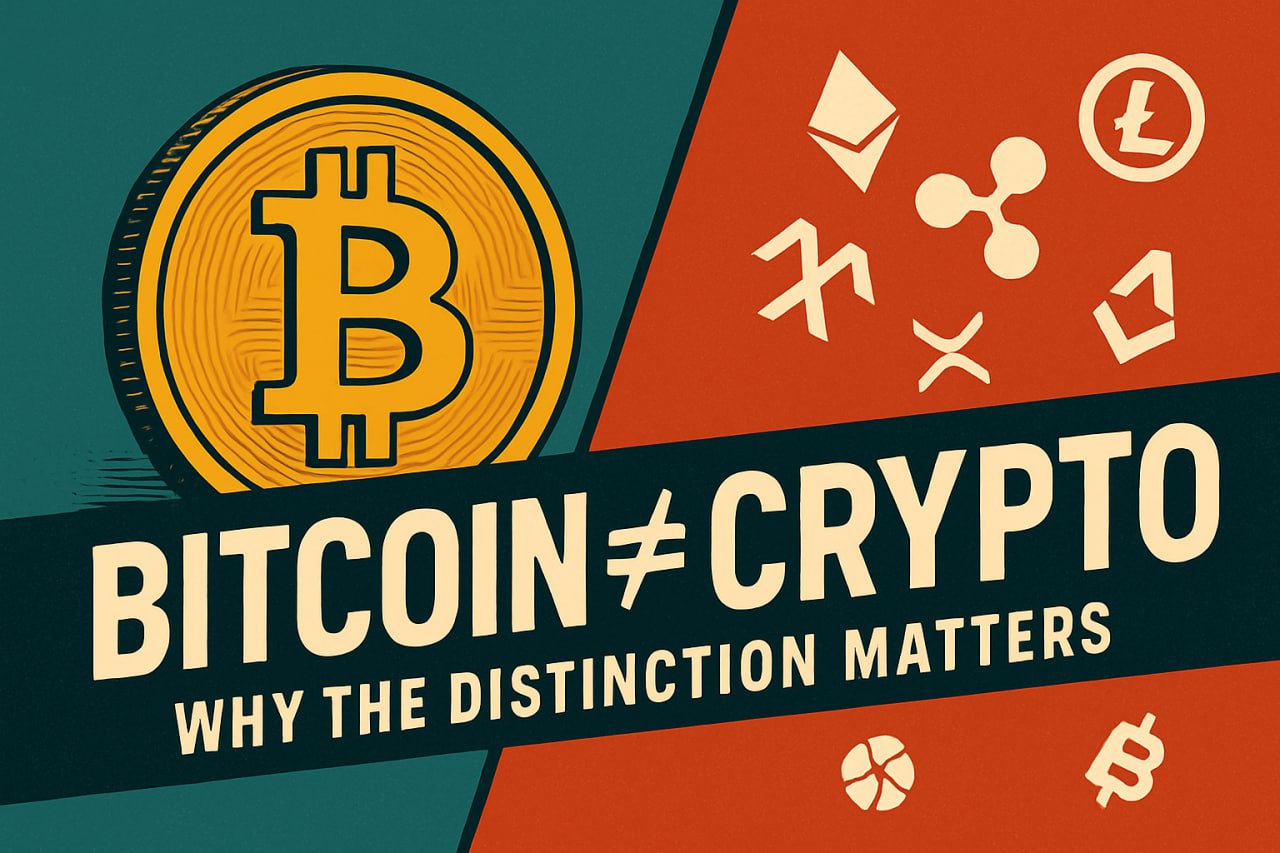Understanding Bitcoin’s unique structure, purpose, and cultural role in a sea of digital noise
The sad reality of the bitcoin ecosystem right now is that most normal people do not understand the distinction between bitcoin and other digital assets, and how and why they are very different things. Bitcoin is based on cryptography and blockchain technology, and many crypto assets are too, but the term “crypto” lumps together a chaotic mix of technologies, tokens, platforms, and ideologies. But as the dust begins to settle, a clearer picture is starting to emerge here. There is Bitcoin, there are stablecoins, and then there is everything else. (Stablecoins won’t be discussed in detail in this article, but they are digital assets that are pegged to the US dollar, or other currencies, and run on crypto rails.) To put it another way, there is Bitcoin, and “crypto” is basically everything else. To treat Bitcoin as just another cryptocurrency is to fundamentally misunderstand what it is and what it offers. Bitcoin’s origins, structure, and culture distinguish it not only from the wider crypto ecosystem, but from any digital system or accounting system that has come before. Understanding this distinction is critical to evaluating the role Bitcoin may play in our financial future, especially for those concerned with equity, resilience, and individual empowerment.
The Power of Decentralization
Bitcoin is the only digital network of its kind that is meaningfully decentralized in several important ways. This is more than a technical achievement; it’s a foundational strength. If any person, company, or group had retained control over Bitcoin, it would have lost its credibility as an apolitical and global financial system. Instead, Bitcoin operates on a consensus model where rules are enforced not by authority, but by thousands of independently operated full-node computers around the world.
Running a node is intentionally accessible and easy to do. A full archival Bitcoin node can be operated on computers as simple as an old laptop or a Raspberry Pi. This ensures that verification is not limited to the wealthy or technical elite. Every node enforces the protocol rules, verifies transactions, and keeps everyone honest. This decentralized consensus mechanism makes it impossible to cheat the system, rewrite history, or alter the supply schedule without the overwhelming consent of the network.
In contrast, other networks based on similar code and blockchains—but lacking true decentralization—have often changed their rules or reversed past transactions. They can and have changed how their codebases work, altered how new tokens are issued, and reshaped the very principles on which they were founded. Bitcoin’s resilience is rooted in its architecture and community, which prioritize resistance to such changes.
Bitcoin’s Immutable Monetary Policy
The problem is inflation. Creating new money from nothing is a form of cheating. If I make a certain amount of money per hour or per year, that value creation should be constant or hopefully growing over time. If the overall supply of money in an economy suddenly grows, then my time, energy, and purchasing power has been diluted, and that’s not fair. That is changing the rules midway through the game.
If we know ahead of time what the total supply of money in the system is and will be, then we can have a meaningful free market competition for some fraction of that supply. Bitcoin has a fixed supply cap of 21 million coins, so it fits this model of having an unchangeable supply that we know in advance.
Could fiat currencies emulate this? In theory, yes. We could imagine the U.S. government declaring, “There will only ever be a max of $10 trillion dollars in circulation.” But in practice, that has never happened and likely never will. Governments and central banks retain the authority to print money at will, introducing unpredictability and dilution of value. Bitcoin removes that authority entirely.
This cap is hard-programmed into the code, enforced by all the nodes, and enshrined in Bitcoin’s culture. No bitcoin hodler would benefit from ever changing this sacred pillar of the system’s design.
Other cryptocurrencies are based on similar code. They use blockchains and might even also have nodes and miners. Yet has the monetary policies of those networks ever been changed? In many cases, the answer is yes. Founders, companies, and early adopters can and do adjust parameters like how many coins there are, how they are created, who gets new coins, and they can go into the system and “fix mistakes.”
Ethereum’s blockchain, for example, has been rolled back to fix mistakes, helping some and hurting others. They have changed their code not just in slight ways, but in meaningful and impactful ways, such as switching from a proof-of-work protocol to a proof-of-stake protocol. This means that miners who did cryptographic work to acquire new coins no longer get them; rather, people who already own a lot of coins get the newly issued supply directly. On the other hand, while Bitcoin is a software technology, it does need to be updated and patched from time to time as new threats and unforeseen issues and use cases arise, but the important values of supply cap, verifiability, low block size limit, and proof-of-work mining protocols are sacred and cannot easily be altered even if a lot of people might want to make a change.
The simple fact that many other crypto systems can and have been altered away from their original intent makes them fail as sound money. They are projects rather than neutral protocols and they are not hard money assets. There might even be a few projects out there (like Litecoin) that are proof-of-work, haven’t been changed much, and might not be outright scams, but how many people are running a node for those projects? Are those nodes geographically decentralized? Do they have a strong community of users fighting for the platform? Are people building layer 2 and layer 3 use-case levels on top of those systems? That’s not the case for Litecoin and most crypto assets. In all of these aspects, Bitcoin stands out as distinct with its hard-coded supply cap, established history, decentralization of both nodes and mining infrastructure, and a cultural layer of protection.
Origins and Ethical Foundation
Bitcoin is often described as having been discovered rather than created, and that metaphor has weight. What Satoshi Nakamoto introduced in the Bitcoin white paper was not just a coin, but a fundamentally new approach to accounting, verification, and decentralized trust.
Many people are familiar with the concept of “double entry accounting” where two records of accounts and balances are kept separately and periodically reconciled. This system attempts to keep parties involved honest and is a notable improvement over the risky practice of having one person in charge of all the money. We all know how well that works… Bitcoin included the realization that a better system of accounting would have ALL the interested parties keep ALL of the financial records and data ALL of the time, and when a transaction needs to be made, ALL of the participants in the entire network should validate and approve the transfer of funds. This is how the Bitcoin accounting system works and was obviously only possible with a network of computers. Every participant in the Bitcoin network maintains a copy of the full ledger, and every transaction must be verified by the collective. It’s decentralized double-entry accounting taken to its logical extreme.
Before Bitcoin launched, Satoshi publicly released the white paper on October 31, 2008, inviting feedback and scrutiny from the Cypherpunk community. The first version of the software went live on January 3, 2009, with an embedded message in the genesis block: “The Times 03/Jan/2009 Chancellor on brink of second bailout for banks.” This was more than a timestamp. It was a political statement, a declaration of intent, and a proof that no coins were secretly mined or allocated prior to the software’s public release when the mining began.
Satoshi did mine the early coins solo, not because he claimed them, but because no one else was there. These coins had no market value. They were earned by contributing energy and computational power to secure the network. There was no pre-mine, no ICO, no investor round, no venture capital funding, no central foundation. It was, and remains, the fairest launch in digital history.
Bitcoin grew slowly. Hal Finney joined. Then a few more. Then a trickle turned to a stream. There was no marketing campaign, no pump-and-dump scheme, no influencer endorsements. Just open-source code and a vision for better money. And that network has continued running—nearly uninterrupted—ever since.
Censorship Resistance
How does Bitcoin fail? What would it take to stop it? For years, critics have warned that “the government will eventually shut it down.” But the very fact that this has not happened, despite multiple efforts and incentives, is part of what gives Bitcoin its enduring value.
Bitcoin is valuable because it allows anyone to transact freely with any peer on the network, regardless of political geography, personal characteristics or history, or government approval. For example, people sending money to family members across borders face high fees, delays, and scrutiny when using traditional systems like Western Union or international bank wires. Recipients may have to travel long distances, wait in line, pay fees, and risk being targeted for carrying physical cash (as demonstrably happens throughout the world). Bitcoin solves this. It offers near-instant settlement, very low fees, and the ability to receive funds without a bank account – all while bypassing financial censorship.
A real-world example unfolded during the 2022 Canadian truckers protest in Ottawa. Supporters raised funds through GoFundMe and other platforms – until those platforms froze the funds, citing political pressure. Some peaceful protestors had their bank accounts frozen, cutting them off from their own money. It was only Bitcoin—peer-to-peer, unstoppable, and uncensorable—that reached them. Bitcoin transactions made it through where traditional rails failed.
Another example: Russian opposition leader Alexei Navalny’s movement was partially funded by Bitcoin. His funeral was also paid for with Bitcoin. In one of the world’s most authoritarian regimes, Bitcoin enabled financial expression that the state could not prevent.
If you were to walk into a bank today and say, “I want to send money to my friend in Russia and it needs to arrive on Sunday at 9 PM,” you would be laughed out of the building – if not flagged for further scrutiny. The banking system is not just slow and expensive; it is conditional. Bitcoin is different.
Even world leaders have acknowledged this. Vladimir Putin has publicly stated that Bitcoin cannot be stopped. And he’s right. There are roughly 23,000 Bitcoin nodes operating globally. To control or disrupt Bitcoin, you would need to shut down the vast majority of them – something no single country or coalition can achieve. Trudeau can’t stop nodes in Africa. Xi can’t stop nodes in South America. Biden or Trump couldn’t shut down nodes in Eastern Europe or Asia. The Bitcoin network transcends political borders.
China has reportedly “banned” Bitcoin at least 19 times, yet the network continues to operate unimpeded with each attempt drawing more attention to Bitcoin’s resilience and decentralization. What does that say about how effective such bitcoin bans have been? If anything, these repeated attempts have only reinforced Bitcoin’s resilience and the futility of trying to suppress an open, borderless protocol.
That’s why the ease of running a node is not a technical detail – it’s a human rights feature. The Bitcoin network is built to survive, even thrive, in adversarial conditions.
Compare that to Ethereum or other cryptocurrencies. How many nodes are there? Where are they hosted? Many rely on massive servers, often running on platforms like Amazon Web Services. That’s a problem. Governments can pressure AWS or other centralized hosting providers to shut down or censor these nodes. Even if the chain survives, the network becomes fragile and dependent on corporate infrastructure.
And that’s before we get into consensus mechanisms. Many altcoins use proof-of-stake, where control accrues to those who already own a large stake in the system. This is less secure and more vulnerable to manipulation or capture. In contrast, Bitcoin’s proof-of-work system makes attacks prohibitively expensive. To alter past transactions, an attacker would need to redo the work of not just one block, but several of them all while trying to outpace honest miners who are incentivized to continue building on the legitimate chain. It’s far more profitable to play by the rules of the bitcoin system than to attack it.
While the decentralization of full nodes ensures that anyone can verify the rules of Bitcoin, the geographic decentralization of mining infrastructure too is just as important. When mining power is distributed across many countries and jurisdictions, it becomes far more difficult for any single government or authority to censor transactions, co-opt the network, or enforce localized restrictions. When China did crack down on industrialized bitcoin mining, the large miners simply went elsewhere: to Kazakhstan, to Vietnam, and, in fact, a lot of them moved to Texas. It took a few weeks, but the hashrate relocated and was back up quickly. Having mining and hashing infrastructure in different political jurisdictions also can help guard against this political uncertainty risk for the miners, but this also strengthens the bitcoin network by incentivizing for distribution of hash-power. Geographic dispersion strengthens Bitcoin’s resilience against regulatory overreach and political coercion, making it truly global and harder to control.
Bitcoin’s censorship resistance is not just a talking point. It’s engineered into its architecture through decentralization, through proof-of-work, and through a global culture of adversarial thinking. It is a freedom-preserving infrastructure for a digital world.
Bitcoin vs. Crypto Culture
Culture is the soul of a monetary network. What gives a network its identity and intangible characteristics is largely the culture of the participants. In Bitcoin, this culture is not dictated by a company or a founder, but shaped organically by the users, node operators, miners, and builders who share a set of principles and long-term goals. Much like how the culture of a country can deeply influence its economic policies, the culture of a company influences its profitability and success, the culture of a network affects its priorities, values, and future direction.
Consider how differently Germany and Greece approached economic life before and after adopting the Euro. Their distinct cultural attitudes toward savings, debt, and fiscal discipline clashed when forced to share a common currency. This created enormous tension during the European sovereign debt crisis. Greece, unable to devalue its own currency or control monetary policy, struggled under austerity measures imposed from outside, while Germany held fast to principles of hard money and fiscal prudence. This cultural mismatch nearly broke the euro system.
Similarly, Bitcoin culture stands apart in the digital asset space. While not monolithic, Bitcoiners tend to share values such as low time preference, sound money, personal responsibility, quality over hype, and resistance to authority. We value stability over innovation-for-innovation’s-sake. We build slowly and carefully. We like things that don’t change, promises that are kept, and monetary policies governed by math and code, not politics.
Just as 1 troy ounce of gold is 31.1034768 grams of gold which is also 9.509×1022 atoms of gold, a fact that is ‘backed’ by physics and math, 1 bitcoin can be divided into 100,000,000 satoshis (lowest single unit of bitcoin visible on the main chain), and regardless of where they are and who owns them, the total supply at any one given time must add up to a number less than but approaching the 21 million bitcoin hard cap (2,099,999,997,690,000 to be precise). These bitcoin units are not arbitrary numerical database entries. Every satoshi has a provable, auditable history that can be traced back to the block it was mined in, and every block is cryptographically linked to the block before it and ultimately to the genesis block. These facts are audited by the Bitcoin network every 10 minutes on average.
To move bitcoin from one address to another, the global network must agree that it’s valid – that its origin, path, and current ownership all check out. No satoshi can be created without the work and consensus required by the protocol. This is a system grounded in fairness, transparency, and thermodynamic cost. The fact that changes and transactions in bitcoin have a real world energy cost (proof-of-work) means that the system can’t be easily or quickly changed, hacked, or cheated. It is not subject to political discretion or corporate override. It is not resettable or reversible. It does not bend to any CEO, developer group, or nation-state.
Bitcoiners defend this system because we believe in what it represents: a level playing field. An incorruptible set of rules. A foundation for building something more lasting than hype cycles or trading apps. We fight to keep it this way because we know that if it ever stops being this way, it stops being Bitcoin.
Why the Distinction Matters
It’s critical to understand that the distinction between Bitcoin and the rest of the crypto ecosystem isn’t just a matter of opinion or preference, it’s foundational and explicit, not academic or pedantic. Confusing the two leads to bad policy, public misunderstanding, and the loss of trust in a technology that actually deserves it. When Bitcoin gets lumped in with the chaos of “crypto,” people assume it’s just another speculative asset, tech startup, or financial scam. But Bitcoin isn’t just different in degree, it is different in kind.
Bitcoin is governed by math, not marketing. It has no centralized team, no company, no pre-sale, and no ability to be quietly upgraded by insiders. The code is open-source and easily audited. That’s not true of most crypto projects, which are often corporate at their core – venture-funded experiments with changeable rules, shifting goals, and a short-term mindset. The distinction matters because Bitcoin operates on principles, not personalities.
Let’s break it down clearly:
- Finite vs. Infinite Supply
Bitcoin has a hard cap of 21 million coins – fixed in code, verifiable by anyone. Most altcoins and all fiat currencies have elastic or inflationary supplies. Bitcoin is the only monetary asset with a provably scarce supply curve. - Predictable vs. Political Issuance
Bitcoin’s supply is predictable to the block – with halvings every 210,000 blocks (~4 years). In crypto and fiat, supply depends on politics, incentives, unlock schedules, or insider decisions. - Energy-Backed vs. Trust-Based Security
Bitcoin uses proof-of-work to anchor its ledger to real-world energy and time. Crypto networks often use proof-of-stake, which centralizes control among the wealthy. Fiat money is secured by government trust and force. - Decentralization by Design vs. Marketing
Bitcoin’s decentralization is real – no founder in control, no kill switch, no reliance on Amazon servers. Most crypto projects are still, at root, companies and are controlled by groups of people seeking profit. - Monetary Philosophy
Bitcoin was created to answer the question, “What is money?” It’s a direct response to the failures of central banking. Crypto projects are mostly tech products or financial games, not hard money revolutions. Bitcoin only wants to be better money and shouldn’t try to be anything else. - Time and Finality
Bitcoin offers irreversible, timestamped, global settlement – a true economic clock. Other networks and fiat systems allow reversals, freezes, and edits. Bitcoin transactions, once confirmed, cannot be undone. - Code as Law vs. Human Discretion
Bitcoin evolves slowly and carefully – governed by overwhelming consensus and a peer-review system. In crypto and fiat, change comes fast, top-down, and often without transparency. Bitcoin is a kind of digital constitutionalism that resists the whims of any single actor. - Cultural Layer and Network Identity
Bitcoin’s culture is grounded in responsibility, long-term thinking, and resistance to coercion. It is not driven by hype, celebrity, or opportunism. In contrast, crypto culture often revolves around speculation, trend-chasing, and yield-seeking. Fiat culture is shaped by consumerism, debt, and political expedience. Bitcoin’s culture encourages stewardship and sovereignty, not just in money, but in mindset.
The point here is not to insult or ignore the rest of the crypto world – some projects may be useful, interesting, or well-intentioned. But Bitcoin is in a category of its own. It’s not a financial product; it’s a monetary protocol. It’s not a startup; it’s a mature digital network. While there may be some legitimate use-cases to non-bitcoin crypto assets, increasingly even among crypto holders, their long-term savings are held in bitcoin, or stablecoins, and crypto assets are used for only short-term speculation, gambling, or other unsavory activities. Recently, when it looked like there was about to be a battle in the White House about which digital assets to include in a reserve, we thankfully ended up with a system that looks like we will have a purely Bitcoin strategic reserve and a separate digital assets stockpile. This decision was made by government officials and crypto entrepreneurs with vested interests in crypto assets, so even they understand the distinct position that bitcoin holds as a resilient strategic savings technology.
To be clear, this isn’t to say there’s no use-case for crypto assets or that no one should engage with them. But they deserve a fundamentally different kind of consideration. Think of it like day-trading penny stocks: it’s legal, and some people genuinely profit from it, but far fewer succeed than believe they will. Day trading is not a responsible, long-term wealth strategy; it’s a high-risk short-term activity that requires constant attention and specialized knowledge in order to be successful. Similarly, crypto assets may offer opportunities for those deeply embedded in the space, but they are not a sound basis for a long-term monetary foundation. Bitcoin, in contrast, offers a stable, principled system designed for generational resilience, not speculative gain. The two should not be conflated.
Failing to make this distinction leads to overregulation, bad regulations, misplaced fear, and missed opportunity – especially for those who might benefit most from Bitcoin’s stability, openness, and fairness. If you care about financial inclusion, human rights, or the separation of money and state, then you need to understand what Bitcoin is, and what it is not.
Conclusion: A Network Worth Defending
Bitcoin isn’t just a technological breakthrough or a monetary experiment. Bitcoin is a moral proposition built on the history of technology, philosophy, and mathematics. It says that everyone, everywhere, deserves access to a fair and open financial system. It offers a form of money that resists censorship, operates beyond borders, and aligns incentives without relying on trust in fallible institutions.
This is not a small distinction. It’s the line between a world where financial power is centralized, opaque, and weaponized and a world where rules are enforced by code, not by decree.
Bitcoin is not crypto. It does not belong in the same bucket, and it should not be judged by the same standards. Where most of the crypto ecosystem chases trends, soft governance, and financialization, Bitcoin holds the line – on trustlessness, transparency, and time-tested principles.
So what now?
- Run a node. Don’t just use Bitcoin: help keep it alive.
- Hold your own keys. Ownership means custody. No one else should speak for your wealth.
- We should advocate for in-kind redemptions of Bitcoin ETFs, ensuring that redemptions could be settled in Bitcoin. Having this option ensures that Bitcoin ETFs don’t rely only on cash settlement, which could introduce trust-based intermediaries and destabilize the system.
- We should encourage Bitcoin treasury companies and holding companies to offer some Proof-of-Reserves auditability to ensure that they are holding the bitcoin they claim to hold. This is easy to do within the Bitcoin system.
- Talk about it. Teach someone why Bitcoin matters – not just as an investment, but as infrastructure for a freer world.
- Stay curious. Keep asking the hard questions. Keep learning. This movement needs more critical thinkers, not just cheerleaders and closet hodlers.
Bitcoin is resistance money. It’s also responsibility money. The system doesn’t work unless we put in our own proof-of-work.
And that’s the point.

Andrew Lonero is a geochemist, lab manager, and Bitcoin advocate with a deep interest in complex systems, both natural and digital. He runs a geochemical research lab focused on environmental systems and climate change, where he works with high-precision scientific instruments such as mass spectrometers to analyze the elemental and isotopic composition of materials. His passion for technology extends beyond the lab, with a long-standing interest in computer hardware, from GPUs to Bitcoin nodes and ASICs.
Andrew first became involved with Bitcoin in 2014, drawn to its open, decentralized nature and its intersection with energy, computing, and financial inclusion. Much like his work in geochemistry, where he deciphers intricate natural systems, he sees Bitcoin as a technological system that requires careful analysis, optimization, and innovation. Through the Progressive Bitcoiner Organization, Andrew is excited to support research that explores Bitcoin’s role in sustainability, economic justice, and social impact.




